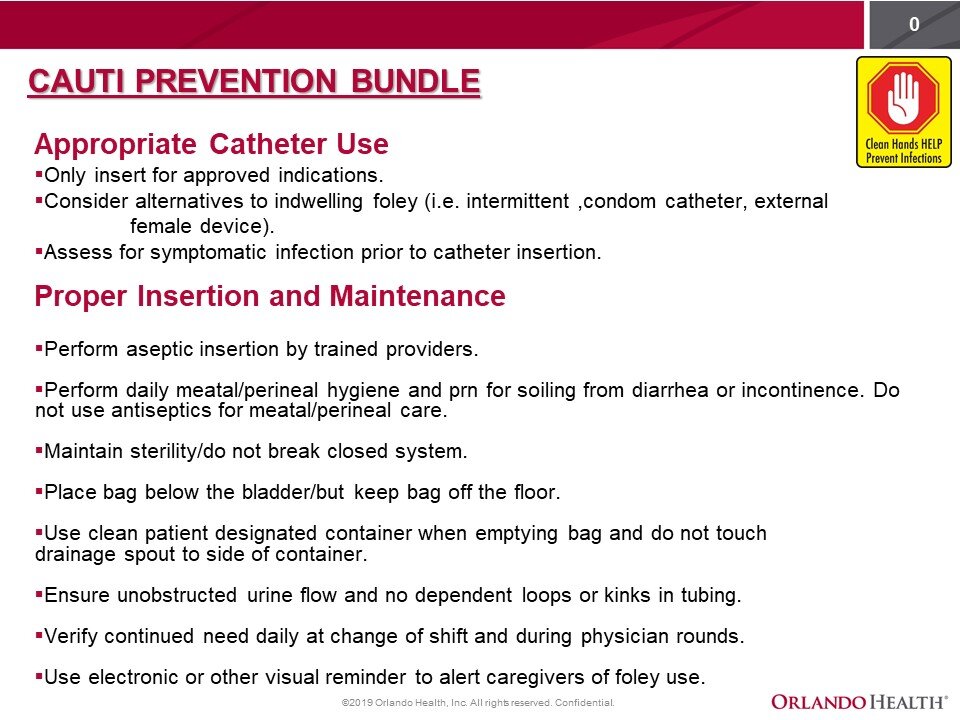Catheter-associated urinary tract infection (CAUTI) FAQ
(adapted from CDC)
What are catheter-associated UTIs (CAUTIs)?
Urinary tract infections (UTIs) are an infection that can involve any portion of the urinary system, including the urethra, bladder, ureters, and kidneys.
UTIs are the most common type of health-care associated infections, and 75% of the UTIs in the hospital are associated with the use of urinary catheters.
Urinary catheters are often utilized in hospitals during major surgical procedures or to prevent kidney injury from urinary retention. However, if catheters are left in place too long, they risk becoming a nidus or focal area of bacterial growth and subsequent infection.
What are the most common bugs responsible for causing CAUTIs?
There are many bugs associated with CAUTIs, but the most common one is E. coli. Among non-catheter associated UTIs, E. coli is also the most common responsible bug. Equally as common are fungal infections caused by Candida species.
Other common bugs include Enterococcus species, Pseudomonas aeruginosa, and Klebsiella.
What are the risk factors associated with CAUTIs?
Female sex
Older age
Diabetes mellitus
Bacterial colonization of the drainage bag
Improper catheter care
What are the recommended guidelines for preventing CAUTIs?
Insert catheters only or appropriate indications and leave in place only as long as needed.
Appropriate indications include major surgical procedures, emergency presentations, or inability to void.
Minimize use in those at high risk of CAUTI, such as women, elderly, and immunocompromised patients.
Avoid using for nursing home residents for incontinence.
Use in operative patients only as necessary.
Remove within 24 hours for post-operative patients.
(OHI CAUTI BUNDLE or LINK)
What steps can patients and team members take to prevent CAUTIs?
The single most important risk factor for developing a CAUTI is prolonged use of the urinary catheter. Therefore, ensure that the attending physician or provider is frequently questioned whether the use of a urinary catheter is still required.
Wash your hands before and after handling any of the catheter equipment. Maintenance of sterility during the insertion and removal of the catheter is imperative.
Ensure that the bag is below the level of the bladder.
Do not pull or tug on the tubing.
Do not twist or kink the tubing.
How do I diagnose the condition? What other things are in the differential diagnosis?
Common signs and symptoms of CAUTI include:
Fever
Flank or suprapubic discomfort
Urinary urgency
Cloudy appearance or foul smelling urine
Low blood pressure
Leukocytosis
Confusion (especially in elderly patient population)
How do I treat/manage the clinical condition?
Treatment of CAUTI includes antibiotic therapy and proper catheter management.
Proper catheter management includes minimizing use of indwelling catheters, removal when no longer required, and intermittent catheterization.
Empiric antibiotic therapy is often started with broad-spectrum antibiotics depending on the patient’s presenting signs and symptoms.
Once urinalysis and culture are obtained and confirmed, antibiotic therapy may be tailored depending on the cultures and sensitivities.
What complications are associated with CAUTI?
The most urgent complication of CAUTIs is the ascent of the infection to the organs of the upper urinary tract, such as the kidneys.
Additional complications include severe progression to bacteremia and sepsis.
Who else can I call for more information?
Hospital Epidemiologist – Asim Jani, MD, MPH : (407) 230-9015 (24/7 cell)
Director, Infection Prevention – Eve Early MT, MA, CIC - (678) 789-6461
Infection Prevention (hospital-specific and/or on call): PerfectServe
Director, Occupational Health – Ken Michaels, DO: (321) 841-8056
What are some additional resources to learn more (online links and literature)?
FAQs:
Videos and Podcasts:
Journals:
UpToDate:
